Every type of swimming challenge and goal you want to achieve has its own most common mistakes and techniques to achieve them. Very often this overarching goal is speed for those who compete. But there’s a lot of swimmers who focus on long-distance training and this requires slightly different technique.
That’s why today we’re going to look at this kind of training and give you four simple tips to swim long distance efficiently and without getting tired.
Long strokes are a crucial element of the efficient long distance swim. To achieve this while using front crawl you have to start with proper body position – flat and horizontal – this is necessary at all times and your movement shouldn’t compromise it as it minimizes the drag and using your every movement more efficiently.
Now that your body is properly positioned you can think about your arms pull – you need to reach as far forward as possible. When you’re pulling back – use maximum force while stretching opposite arm as far forward as possible and so on. These two things (stretching arms while your body stays flat and horizontal) are the basic mechanism that will propel you in the most efficient way. and that means more power preserved for your long distance swim. Short arm pulls give you less propulsion with higher energy consumption so don’t do it!
Your muscles need oxygen. Your muscles while swimming need A LOT of oxygen. This is pure biology and you have to accept it and adapt to it if you want to see any success in long-distance swimming.
There are three basic rules that combined will help you breathe while swimming in a way that gives your body oxygen while it is not producing drag or distraction.
1. Keep your face in the water. We know it might be uncomfortable at the beginning but it is a must as you swimming with your head up your hips and legs will go deeper underwater and you will lose the body position we talked in the previous section.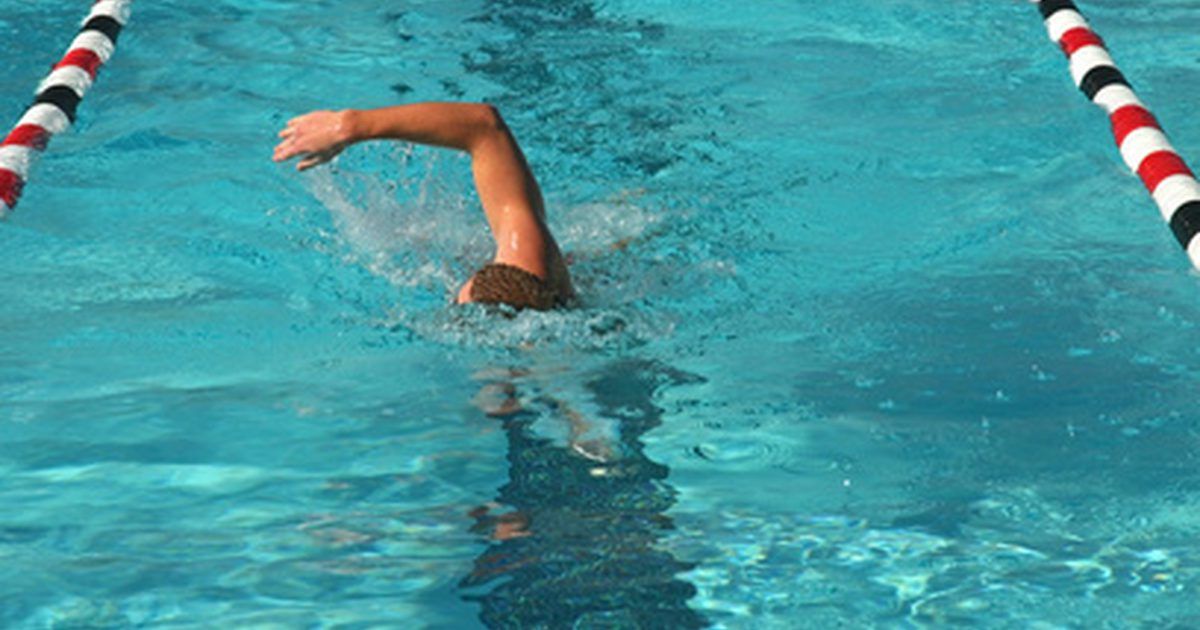
2. Exhale under water. This is the most common mistake among beginner swimmers – they exhale and inhale quickly when they turn to breathe. This gives you little oxygen and holding your breath underwater doesn’t help you either. The proper way is to breathe in while turning and breath out with your head already in the water using your nose and mouth. That is another thing might seem uncomfortable and at the beginning, it will be, but that’s the way of getting as much oxygen while minimizing the time your face is out of the water and your head is up.
3. One-sided breathing. For long distance and any hard swimming session, the way to go is one-sided breathing pattern that gives you good rhythm and good flow of the oxygen. The thing to watch out for is a slight body imbalance you need to correct when breathing on one side only.
The sum of all these rules implemented means more oxygen and better rhythm while swimming and that means more power and efficiency in the water.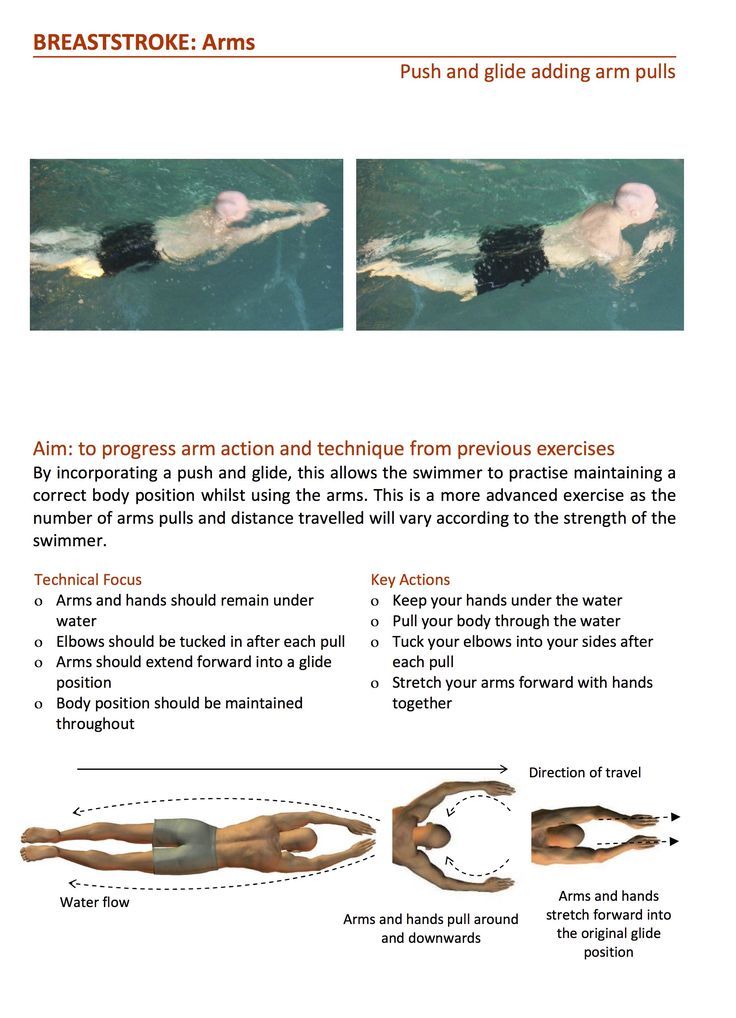
Swimming is very taxing for our bodies as far as calories burned and need for fluids. You can read our articles on nutrition and water consumption for swimmers. The general rules are to eat whole grains, vegetables and plenty of lean protein while drinking A LOT of fluids during your training sessions and competitions. To produce the energy you need for long distance swimming you need to provide it to your body first!
Always remember to have a big bottle of water and few energy bars with you to snack between the sets. It’s really incredible how much calories we burn and how much we sweat during an intense swimming session!
Long distance swimming is a constant process and as in cycling and running you need to set your workout goals in a particular way so you can progress gradually. Attacking full 10k at the beginning can only end up with an injury or you losing all your motivation. That’s why you should build your sets by starting with 50 meters at a certain pace for 10 intervals and then move to 75 meters and 100 etc. This will build your fitness and endurance while you also improve your stroke technique and efficiency in the pool. That is the safe and much more satisfying way to get there as you will constantly see progress and will be able to finish your sets without having a nervous and physical breakdown! :)
This will build your fitness and endurance while you also improve your stroke technique and efficiency in the pool. That is the safe and much more satisfying way to get there as you will constantly see progress and will be able to finish your sets without having a nervous and physical breakdown! :)
In our years of conversations with long-distance swimmers, the simple things like lap counting and keeping a steady pace (not starting too fast) is just as important as post-training analysis and constant control over the progress they’ve made already. Swimmo training watch for swimmers can help with all of those things and much much more resulting in healthier and more effective training sessions that will result in you being able to do longer distances and better pace without getting completely exhausted.
Kamil Market Development Expert at Swimmo
For the majority of swimmers, being able to swim for longer without getting tired is directly related to your swim technique and not your level of fitness.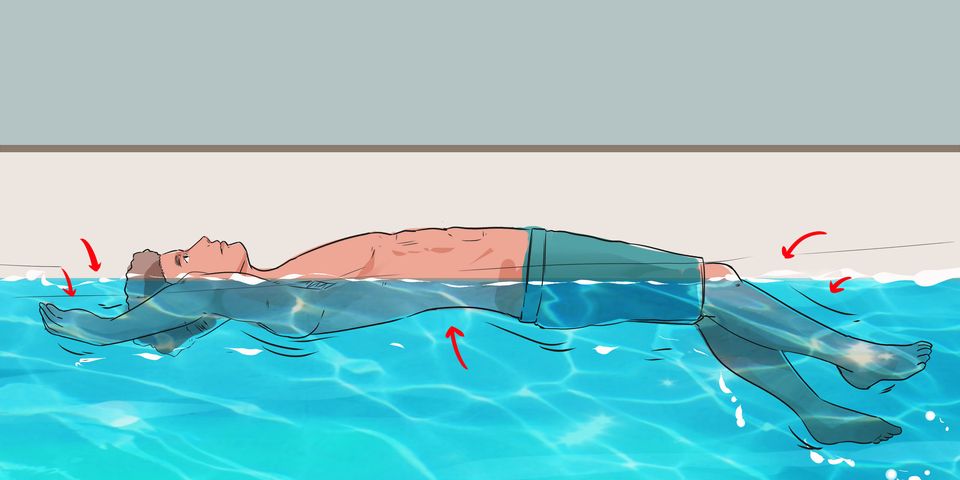
You could be a marathon runner with an excellent fitness level, but one length of the pool can leave you exhausted and gasping for air.
In order to swim for longer without getting tired, you need to relax in the water, stretch to your maximum length, reduce your kicking to a 2-beat kick, consider your body position and improve your breathing technique. By working on a few key areas, you can quickly improve your long-distance swim ability.
With some minor adjustments to how you swim, you can become a long-distance swimmer and not even feel that you are working out.
In this article I am going to look at:
It can be very frustrating to go to the pool hoping to do a 45-minute workout only to be exhausted after one length.
If you are not a regular swimmer, you might find yourself staring over at the superhumans in the fast lane zipping up and down the pool with a mixture of awe and confusion.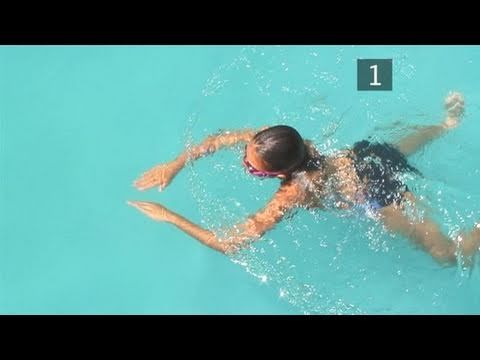
It might particularly frustrate you as outside of the pool you consider yourself a fit person, therefore it makes little sense for you to be gasping for air after 60 seconds or one length.
If you find yourself in this position, you are not alone.
Many individuals want to swim for longer (be it long distance or just more time) but cannot overcome the sheer exhaustion they feel after a couple of lengths.
The secret to unlocking your potential to swim all day long and for miles without being out of breath is technique.
The great thing about the following tips to improve your technique is that you do not need to sign up for expensive swimming lessons or need a personal coach to do them.
The following are simple modifications you can make to your front crawl stroke to allow you to swim for longer without getting tired.
The next time you are in the pool, try these out and you should see an instant improvement.
Personally, I recommend trying these things in the shallow end so you can stand up and take a breather if you find yourself getting tired.
Like many beginners, when I first started swimming I thought that speed was all about kicking your legs fast but this is not true. Kicking only contributes to around 15% of our power.
When you kick your legs fast, you quickly become tired.
Although there is much debate on how much you should kick as you swim, if you are getting tired you need to kick less.
The reason beginners kick so much is that their legs typically sink when they swim, creating drag. Our instinct is to kick more to counteract this effect. However, this will not work and you will quickly become completely exhausted.
The secret is to push your head and upper body down into the water as you swim, which will cause your legs to pop up, creating less drag. I have found this to be the number one tip in learning how to swim without getting tired.
Your upper body is full of air from your lungs, so won’t sink. As you press your head and upper body down into the water, your legs and hips will naturally rise, creating less drag and better balance in the water.
Since our chest is so buoyant as our lungs are filled with air, you should reach a point where you feel the water pushing up against your upper body. (Imagine pressing a beach ball into a body of water – it will reach a natural point where it becomes hard to submerge)
From pressing your head and upper body into the water, you should reach a suitable position of balance where your legs and hips are high.
Now as you swim front crawl, you are not dragging your legs. You should feel a natural propulsion and momentum.
Here is a quick summary of how to do this:

It might amaze you to realise how far you have floated just on the propulsion from kicking off the wall.
Good water balance with your head pressed down into the water, which acts as a counterweight to raise your legs and hips, will allow you to float with natural momentum with no kicking or arm strokes.
If you are getting tired in the pool, you need to learn to kick less.
As mentioned, it is natural as a beginner to want to kick like crazy to swim fast and keep your legs up, but this is not helpful.
If you ever watch long-distance swimmers, you’ll notice that they kick very little. The most common kick for long-distance swimmers is a “two-beat kick” which is kicking twice per full stroke cycle.
Even some Olympians in long course swims will reduce their kicking for most of the race to conserve energy and then increase their kicking for the last 50m for speed.
The secret to learning to kick less is linked to point one already discussed, which is to push your head down into the water to allow your legs to pop up.
If your legs and hips are high in the water, you will not be dragging them.
It is all about balance in the water. Your position should be flat in the water with your legs high. In this position, your arms and hip rotation can help you move through the water with some gentle kicking.
To stop yourself from getting exhausted, kick less.
Imagine trying to run while holding your breath. You would quickly become exhausted and start gasping for air, as your body needs a constant stream of oxygen to keep working efficiently.
The same is true for swimming. It is very difficult to swim if you are holding your breath.
As a beginner or someone who is new to swimming long distances, it is critical that your breathing is natural, controlled and regular.
With good breathing techniques, you will breathe in a way that feels natural.
With practice, you will breathe just as efficiently in the pool during a long swim as you do during a run.
In order to breathe naturally, you must feel relaxed in the water.
From minor discomfort to panic, it is natural for our breathing to become laboured if we are in an uncomfortable situation.
If you are completely relaxed in the pool, breathing becomes natural and something we don’t think so much about, just like running.
When you need to exhale, exhale into the water to empty your lungs completely, then inhale naturally as you turn your head to breathe.
It can feel strange at first to exhale into the water, but you can try this in the shallow end by simply placing your head in the water and blowing out light bubbles through your nose.
Only try this at the shallow end for safety. Once you get used to this, you can incorporate it into your front crawl stroke.
Here is an excellent video that can help you breathe more efficiently as you swim.
Swimming is all about propulsion in the water. The more efficiently you use your body to move through the water, the further you will swim and the less effort you will exert.
When you swim, it is really beneficial to roll your body from side to side.
Instead of having your shoulders flat in the water, rolling your body so that your shoulders are almost perpendicular to the surface of the water will allow you to cut through the water like a knife.
This will help you move faster through the water with less kicking.
Some balance is required when you try this at first, but by simply attempting to swim more on your side than your belly by rolling from side to side, you will feel a dramatic improvement in propulsion and speed.
There is a reason most professional swimmers are tall, and that is because they have a natural advantage in the pool.
Other than being able to reach the far wall in fewer strokes, being tall or long is important in the water.
No matter what height you are, if you stretch your arms and legs to make yourself as long as you can in the water, you will see a dramatic improvement in how you swim.
Here is how you can try this in the pool:
When you extend your arm in front of you in the front crawl, stretch your body and imagine that you are reaching for the far pool wall.
Don’t be afraid to leave your hand in that extended position for a start so you can experience how it feels.
This arm extension and imagining that you are reaching for the pool wall will also cause your body to rotate and you will more naturally swim on your side, which is already mentioned in point 4 above.
Here is a really nice swimming example that shows very calm and graceful swimming. Notice how the swimmer extends their arm out in front of them as they swim.
Notice how the swimmer extends their arm out in front of them as they swim.
Their body position is long and extended and perfectly balanced in the water.
It is perfectly possible to be a very fit person, running 10k or even marathons in your spare time, but then being absolutely exhausted and out of breath after just a couple of lengths in the pool.
If you are tired after swimming a short distance in the pool, even if you consider yourself a relatively fit person, you are most likely tired because of poor technique such as kicking too much and a poor breathing style.
I do not consider myself a fit person outside of the pool. In fact, if I run for one minute at a moderate pace, I am out of breath, yet, I can swim for hours in the pool, completing length after length without being out of breath.
In fact, if I run for one minute at a moderate pace, I am out of breath, yet, I can swim for hours in the pool, completing length after length without being out of breath.
This long-distance swim ability is down to technique.
Here are the main reasons you might tire quickly while swimming:
If you would like to know how to swim for longer without getting tired, I recommend checking out the Total Immersion Swim Method.
This is a taught swimming method that will teach you how to move smoothly and efficiently through the water.
As a result, you will find that you will swim long distances without getting tired. Once you master the art of swimming efficiently, it becomes as easy as walking.
I appreciate that might be hard to believe if you are a beginner and tired after one length of the pool, but once I modified my swim technique and followed the principles set out in the Total Immersion Swim Method, I went from being exhausted after one length, to swimming a mile within one week.
You can learn the Total Immersion Swim Method either from a book, their instructional DVDs, or through free tutorials on YouTube.
It really can be life-changing to learn how to swim efficiently.
I have covered the Total Immersion Swim Method and what it is in my article, “Total Immersion Swimming – What it is and how it works”. This is absolutely worth checking out if you want to learn to swim for longer without getting tired in a short amount of time.
Happy swimming!
We discuss the technique of swimming for long distances. However, experts assure that one kilometer is not a long distance at all.
When I was young, I watched Vladimir Salnikov swim 800 meters or 1500 meters and admired him. Then I did not know that over time he would become a very mediocre head of the swimming federation. At that time, I, swimming maximum from side to side, thought only of one thing: how can one swim such an extra-long distance? At that time, I had never even heard of open water swimming in the form of 10 kilometers, about triathletes, for whom swimming three kilometers is like just accelerating-razz 
Beginner swimmers often don't understand how to swim long distances without stopping. The idea to overcome a kilometer and more seems absolutely unattainable to them. In fact, everything is quite simple, experts say.
The key to conquering long distances is to structure your training so that the length of the short distances that you can swim without getting tired is constantly increasing.
There are a couple of ways to gradually increase your swim distance. You can choose any of them, starting with 25 meters and ending with a marathon distance. Somewhere between 500m and 1km of continuous freestyle swimming, there will be a turning point when further distance increase will be very easy for you.
Method one: Set of short distances.
Favorite example:
4 x 25m
3 x 50m
2 x 75m
1 x 100m
Adding the distances, we get 500 meters.
By doubling each distance, we get 1km.
A key feature of this set is rest between runs. As soon as you feel that after any of the distances you need the same time to rest - this is a signal to increase the distance!
As soon as you feel that after any of the distances you need the same time to rest - this is a signal to increase the distance!
Method Two: Interruptible
You interrupt a long distance swim when you feel you are losing ease or control over your technique. An interruption can be either a few breaths at the side, or a change in swimming style, say, to breaststroke, at 25-50m. Over time, you will develop balance, a sense of the water, and a stable swimming technique while maintaining a moderate heart rate. This will allow you to interrupt less and less frequently. When training in this way, it is important to constantly be relaxed and follow the technique.
Both methods will eventually allow you to swim a kilometer without stopping. At the same time, at the end of the workout, you will feel that you can swim the same amount! This program can stretch for several months, but takes place in a more gentle mode.
Here are some more simple video tips for beginner swimmers:
And this is a tip from my favorite - champion Ekaterina Seliverstova. How to swim and lose weight? Everything is very simple:
source: Sovetsky Sport
Front crawl is the fastest and most efficient swimming style. It is used as a base in freestyle swimming, open water swimming and triathlon. The crawl swimming technique has its own characteristics, which are worth paying attention to - and now, in winter, it's time to go to the pool to learn how to swim and improve your technique.
Help us figure it out Danil Antonenkov , world record holder, two-time European record holder and multiple Russian record holder in swimming in the Masters category, founder of the SWIMLAB Swimming Laboratory.
Benefits of swimming - what strengthens swimming in the pool and what muscles work, how many calories are burned from swimming back and back forward. At the same time, the legs make alternate wave-like movements. Breathing is carried out when rowing in one or in different directions.
At the same time, the legs make alternate wave-like movements. Breathing is carried out when rowing in one or in different directions.
The types of crawl are usually divided according to the criterion of footwork: there are two-, four- and six-stroke crawl. The name reflects the number of kicks that a swimmer performs in one cycle of movement. One cycle is two strokes with hands, right and left. It is also possible to single out sprint and stayer technique according to the criterion of changing hands.
For long distances (800-1500 meters) professional athletes use two- and four-stroke technique - it is more economical. Short distances swim with a six-stroke crawl. But there are exceptions when long distances swim with a six-stroke technique or even change style right during the swim.
Beginner swimmers are strongly advised to start with the basic two-stroke technique.
Freestyle swimming technique (video):
In freestyle swimming, the hands make alternate movements and go through several phases during the stroke.
Capture . The swimmer must catch the water using the so-called high elbow, that is, first the hand, wrist, forearm moves down and back, and only then the elbow and shoulder. The arm is bent at the elbow joint, but not much. The angle must be obtuse, not less than 90°. Thanks to this, an optimal vector for further stroke is formed. In this phase, the deltoid muscle of the shoulder works.
Pull-up . The arm continues to bend at the elbow joint (up to 90 °), the hand goes under the chest, stomach and down closer to the pelvis. This is where the latissimus dorsi muscle comes into play. In the underwater phase, the palm breaks slightly relative to the forearm, forming an angle. The palm should look back and direct the water along itself.
Take off or end of stroke - the final underwater phase. The arm is straightened at the elbow joint. This happens due to the triceps. The hand goes from under the pelvis to the thigh and along the thigh, thereby pushing the water back.
Hand out of the water . The surface phase of the stroke begins. The shoulder rises, the elbow, forearm, hand come out.
Pronos . Due to the movement of the shoulder, the arm is carried forward. Good amplitude and rotation of the shoulder joint is important here. The deltoid muscle of the shoulder is working, and the forearm, biceps and triceps are relaxed.
Water attack . Entering the arm into the water and straightening the arm under water. The angle of attack of the water can vary, it can even be zero, but it should not be negative (when the elbow enters the water first). Usually, the arm is fully extended already under water. The palm is a shoulder blade - the fingers are gathered together.
Danil Antonenkov: “There is an open discussion among swimming coaches about fingers. Some people think that there should be a small gap between the fingers. I believe that the structure should be rigid so that water does not seep between the fingers. The palm should work like a paddle. In this case, the thumb should be protruding to the side. This gives rigidity to the structure.
In freestyle, the legs move alternately. In this case, the hips, shins and feet are included in the work. The movement comes from the hip in such a way as to create the effect of a wave - a wave-like movement like a fish tail or flippers. The movement of the hip should be backwards (in the prone projection - up), the legs are bent at the knee joint, but not excessively. After bending at the knee, the leg should be fully extended at the joint in antiphase.
Danil Antonenkov: “The main mistake of beginners is that they do not work with the hip, but only bend the knee and make movements with the lower leg. In this way, they often push the water forward, thereby minimizing progress and even staying in place. We need to achieve undulating movements. It happens precisely due to the work of the hips.
The foot must work like flippers, be flexible and bend both up and down under water pressure. These should not be muscle movements, the foot in the water is relaxed.
Danil Antonenkov: “Fans often have very hard feet, especially those who started swimming from running. In such cases, you can slightly skew the foot inward. Many people say "pull the sock", but for a beginner this will become a problem. The foot will tense up, which can lead to cramps. Also, trying to pull on the toe leads to stiffness in the foot, and it stops bending.
Amateurs are advised to start with a two-stroke freestyle and then move on to a four- and six-stroke version, because in the initial stages the legs are still too weak: in swimming, muscles are involved that are not strongly involved in ordinary life.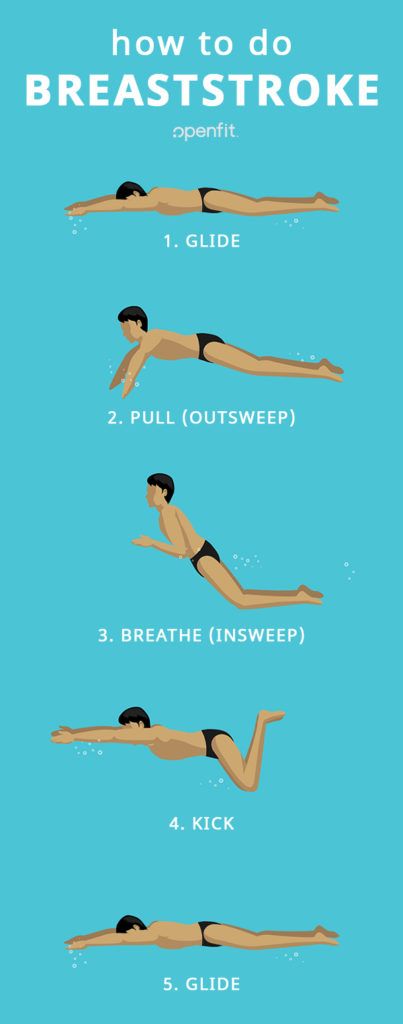
There are two options for breathing - every third stroke, then the sides change, or every second. In sports schools, children are taught to breathe every third for the following reasons:
If we talk about amateurs and adults, it is recommended to breathe on every second stroke in one direction. The main problem with breathing on the third stroke in adults is that the breaths are very rare, and the swimmer does not have enough air.
Danil Antonenkov: “When breathing for every second stroke, there is a distortion, so learn to breathe in both directions. To do this, simply change sides every 100 meters. First inhale under the right hand, and the next 100 meters - under the left.
Breathing should be comfortable, as when walking or jogging, but with its own characteristics:
For beginners, it is recommended to exhale only through the nose (because it is easier to stretch the exhalation time, and this also prevents water from entering the nose), for more advanced swimmers - through the mouth and nose. Exhalation begins immediately after the face is lowered into the water, or with a minimum delay.
Danil Antonenkov: “There is such a thing as a hitch. This is when the face is out of the water, but the mouth is not open yet. For professionals, the hitch time tends to zero, while for amateurs, the hitch can be large. All this is trained by practice in the water.
Breathing should be shallow, do not try to take a maximum breath, especially when swimming lightly.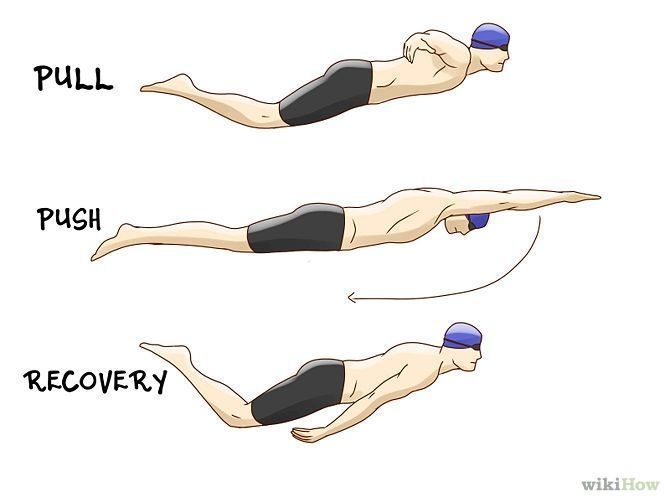 Then there will be no tension and it will be easy to exhale everything. With an increase in the pace, the body itself will increase the volume of inhalation, this will happen naturally by a reflex, because more oxygen is required.
Then there will be no tension and it will be easy to exhale everything. With an increase in the pace, the body itself will increase the volume of inhalation, this will happen naturally by a reflex, because more oxygen is required.
Correct breathing technique:
Danil Antonenkov: “Legs-hips-pelvis-back-head-crown – all together form a straight line in a horizontal plane. The crown is directed forward, and the gaze is down. In no case should you look forward, because when you raise your head, you shift the center of gravity back, because of which your legs begin to sink. As soon as you break a straight line, an angle immediately appears - the head is a little higher, the legs are a little lower. Because of this, frontal resistance increases, and the speed drops. Your job is to keep your hips high."
Mistakes are made by beginners and experienced swimmers alike, as freestyle swimming takes years to perfect. Danil Antonenkov notes the following among the most common mistakes.
Danil Antonenkov notes the following among the most common mistakes.
1. Balance error is the main mistake for beginners. The swimmer lifts his head and thereby drowns his feet. Although our body has good buoyancy, it is unevenly distributed. The upper part of the body - the head, lungs, abdomen - have good buoyancy, but the legs are bad, so they always sink.
What needs to be done to fix the error
It is necessary to use the effect of a swing / weights - press on the front of the body, shift the center of gravity slightly forward and unload the legs. This is called "getting on the water".
Advanced amateurs also have balance errors when it is not possible to shift the results. The main problem is streamlining: the athlete adds power, but water resistance makes it difficult to add speed. It is necessary to work with balance at all stages of training and improvement.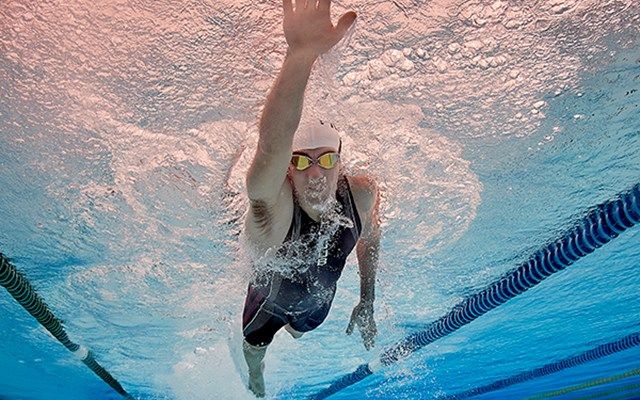
2. High inhalation – fear of putting one's head into the water. Beginners, when inhaling, raise their heads up and lift the crown, which shifts the center of gravity back and drowns their legs, that is, they break the balance.
What needs to be done to correct the mistake
Learn the technique of “flat” inspiration:
With this technique, you do not disturb the balance and do not lift the front of the body.
Flat inhale training:
3. Changing hands . Beginners often float like a river - one hand rows, the other sweeps.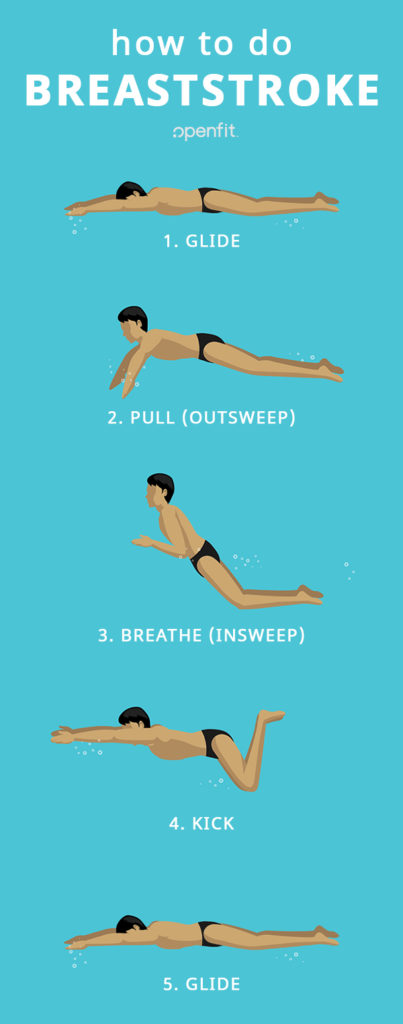 A lot of effort is spent, a person quickly gets tired.
A lot of effort is spent, a person quickly gets tired.
What needs to be done to correct the error
If you want to swim correctly and for a long time (for long distances), then you need to change hands at the very last moment.
More experienced swimmers make the mistake of changing hands. Many also ignore the recovery phase of the carry-over. Swimming is a cyclical sport where you can't work all the time. There must be a rest phase. In this short time interval, when the swimmer carries his arm, it is necessary to relax the muscles of the arm (biceps, triceps, forearm), except for the muscles of the shoulder, which are directly responsible for the sweep. The hand also rests while sliding forward. It is necessary to learn how to straighten the arm at this time without any extra effort - not to “reach out”, but to “straighten up”. A good carrying technique is also an injury prevention.
4. Coordination of the movements of the arms and legs . Often, advanced and even experienced athletes may experience desynchronization in the movements of the arms and legs, especially in the four- and six-stroke freestyle.
Often, advanced and even experienced athletes may experience desynchronization in the movements of the arms and legs, especially in the four- and six-stroke freestyle.
What needs to be done to correct the error
Start with a two-stroke crawl and only then move on to other variations. It's like a transmission in a car. You start at low RPMs and then move up to higher RPMs. All movements are synchronized and consciously controlled by you at will. You must learn to coordinate the movement of the arms and legs and not allow the spontaneous work of the legs.
5. Underwater part of the stroke . It is extremely important to properly hook on the water and set the correct stroke trajectory. You can develop strength, but if it is not applied correctly, nothing good will come of it. The underwater part of the stroke consists of three phases - capture, pull-up and repulsion. And these elements need to be worked on, especially for advanced athletes.
Danil Antonenkov: “Just as a house is built from the foundation, the equipment is built in order. You can not move on to learning to carry and capture until a person has learned to lie on the water.
In my methodology, I divide all the elements into several levels:
The initial elements can be set in 6-12 workouts, and the underwater part of the stroke can be practiced for a very long time.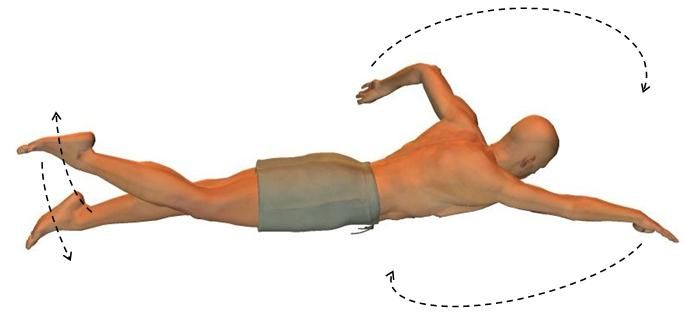
The first priority is balance. How to understand if you are doing everything right? At the initial stage, speed is not important, lightness is important. You should lie on the water, calmly do strokes, exhale, do not accumulate oxygen debt. There should be no fatigue in the muscles and acidification. Water holds you, and you move forward. When you can swim for an hour without stopping and fatigue, then we can say that the basic elements have been learned. Here you can already add and move on.
The second point: we must strive to do everything right at once, not to fix unfinished elements. You have to strive for perfect performance, otherwise it will be more difficult to relearn muscle memory later.”
Now there are many competitions for amateurs - swims in open water, triathlon. We asked Danil for some advice for those who are planning to swim long distances outside the pool.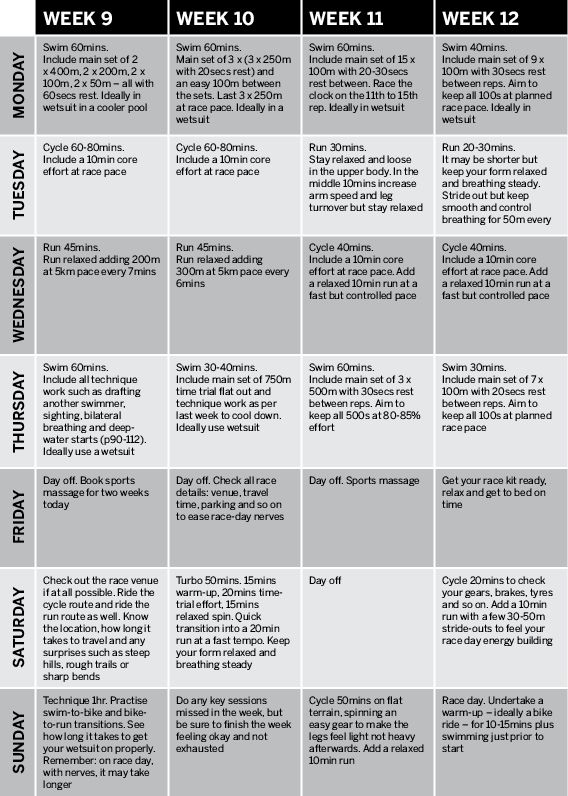
Danil Antonenkov:
“1. Learn to float on the water. Without this, all swimming will go on from strength: while a person is swimming, he does not drown, if he slows down a little, he immediately begins to sink.
2. Change hands later. Beginners can even take turns working with their hands.
3. In triathlon, since there is still cycling and running ahead, use only the 2-stroke front crawl.
4. Learn to navigate in space. There is no walkway in open water and no underwater markings, so you have to raise your head to look at the buoys. You can do this in different ways:
5. Breathe every other stroke. In open water and for long distances, the stroke rate is usually low, so you should not breathe on the third stroke.
6. Learn to alternate work and relaxation. Swimming is a cyclical type, strokes go one after another. It is important to tighten the muscles of the arm in the stroke to move forward, and relax in the sweep phase, as well as on the slide. This skill must be brought to automatism so that swimming is fast, easy and without tightness. This is extremely important for long distances."
Photo: Gettyimages.